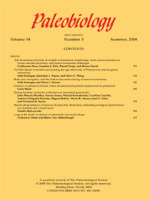Although direct predator-prey interactions are unobservable in the fossil record, predation has been used to explain many evolutionary trends. Evidence of predation supporting such hypotheses is often presented as isolated instances of preserved sublethal damage, and less commonly, as the frequency of such injuries. For instance, numerous morphological and ecological trends and innovations observed in Phanerozoic crinoids have been causally linked to predation, and whereas the high frequency of arm regeneration in living crinoids is generally assumed to represent intense predation, attempts to assess regeneration frequency and patterns in paleontological samples are few. Can the frequency of fossil injuries be assessed to test hypothesized predation-driven trends, or are such data unavailable?
To address this question, we analyzed regeneration in crinoids from the lower Mississippian (Kinderhookian) Maynes Creek Formation near Le Grand, Iowa, a locality renowned for the preservation of thousands of crinoids in tangled masses of crowns, stalks, and holdfasts. Nine percent of the specimens that we examined contained at least one regenerating arm; however, whereas some species lacked evidence of regeneration, others preserved up to 27% arm regeneration. Furthermore, we observed specimens with all arms regenerating, multiple adjacent arms regenerating from the same place along the arm, and a specimen with a damaged and regenerated primaxil and anal sac.
The highest regeneration frequency was observed in the most abundant species, Rhodocrinites kirbyi, a significantly higher value than expected under a model of no taxonomic selectivity (binomial: p < 0.05). Furthermore, bootstrapped simulations of the probable number of regenerated individuals suggest that the number of regenerated arms observed in our sample is two to three times less than what existed in the living population. Rhodocrinites kirbyi constituted over 40% of the individuals in the Le Grand crinoid fauna and had the longest stalk of the studied species. In addition, regeneration in R. kirbyi is size related, with individuals above median dorsal cup height (7 mm) displaying nearly 50% regeneration, and smaller individuals only 2% (a statistically significant difference; χ2 test: p < 0.001). The regeneration patterns in R. kirbyi are consistent with predatory attacks that target the most apparent prey. Moreover, this study suggests that predation is the most likely explanation for the regeneration patterns observed in Le Grand crinoids, and that the fossil record potentially provides a valuable, yet overlooked, data source for testing hypotheses pertinent to the role of predation in the evolution of Phanerozoic marine life.





